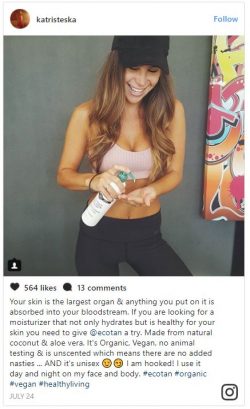Back in February we broke down what the new guidelines from the Australian Association of National Advertisers (“AANA”) would mean for brands and agencies engaging social media influencers.
The Advertising Standards Board has now given insight into what level of disclosure is expected under Section 2.7 of the AANA Code of Ethics (“Code”) in its recent determination involving the self-tan and body care manufacturer, ‘Eco Tan’.
Section 2.7 of the Code requires that advertising or marketing communications must be clearly distinguishable as such to the relevant audience.
The determination addressed a complaint that an Instagram post from Kat Risteska, an influencer with over 14,000 followers, did not distinguish itself as an advertising or marketing communication by using #ad or similar. The post featured Risteska holding an Eco Tan product with a caption that was spruiking the product, its characteristics and how she was “hooked”. Rather than paying Risteska to post about the product, Eco Tan sent free samples of their product to Risteska with a request for her to write an honest review for her Instagram followers.

Ultimately, the Board adopted a realistic approach and dismissed the complaint, finding that while the post was in fact an advertisement and fell under the Code, it did not breach Section 2.7.
Are posts involving ‘gifted’ products advertising or marketing communications?
“Advertising or Marketing Communications are any materials published or broadcast using any medium or any activity undertaken by, or on behalf of an advertiser or marketer, over which the advertiser or marketer has a reasonable degree of control, and that draws the attention of the public in a manner calculated to promote or oppose directly or indirectly a product, service, person, organisation or line of conduct.”
In short, the Board says yes! The Board found that sending a person free samples amounted to a business transaction and as such could be considered a form of payment. Additionally, the Board held that the fact that Eco Tan requested a review of their product and then reposted Risteska’s material on its own social media account established the company’s ‘reasonable control’ over the post for it to be considered an advertising communication.
Was the post clearly distinguishable as advertising to the relevant audience?
The Board considered that the post was clearly distinguishable as an advertising or marketing communication because it read like a “press release” and because the use of ‘#ecotan’ and ‘@ecotan’ made it clear to Risteska’s followers and other users of Instagram (being the relevant audience) that the post was promoting a product, even in the absence of #ad or #spon.
To #ad or not to #ad?
Whilst this determination reveals that the Board has not necessarily imposed a requirement to #always #explicitly #hashtag #ad #or #spon, disclosure is not only an obligation under the Code but is important to reduce the risk of misleading or deceptive conduct under the Australian Consumer Law. The determination also shows that the Board’s approach to each social post won’t necessarily be a ‘one size fits all’ approach, and that various factors will be considered. The degree of control is particularly important in determining whether a post is an advertising or marketing communication.
A careful assessment of the audience must also be undertaken in order to assess the level of disclosure and whether there should be use of #ad, #spon or similar. The level of disclosure required will often be determined on a case by case basis having regard to who the influencer is and the demographic of his or her followers, together with the nature of the product and promoting brand. Sometimes an influencer becomes an ambassador for a brand or certain product category, but where they step outside of such ambassadorship, the advertisement may not be clearly distinguishable and will therefore require more prominent disclosures.
In our view, the fundamental success of influencer marketing is the degree of trust and authenticity an influencer has with their audience, and not being transparent about commercial relationships can seriously diminish that trust. Our guidance is simple: always take the best practice approach of being transparent and honest with influencer advertising and marketing communications and use a hashtag if there are any residual doubts. Agencies and brands should be clear on the importance of transparency and honesty and the relevant disclosures required when engaging social media influencers.
Want to know more? Contact us #here.
Written by the VML Team
This article first appeared in Mumbrella